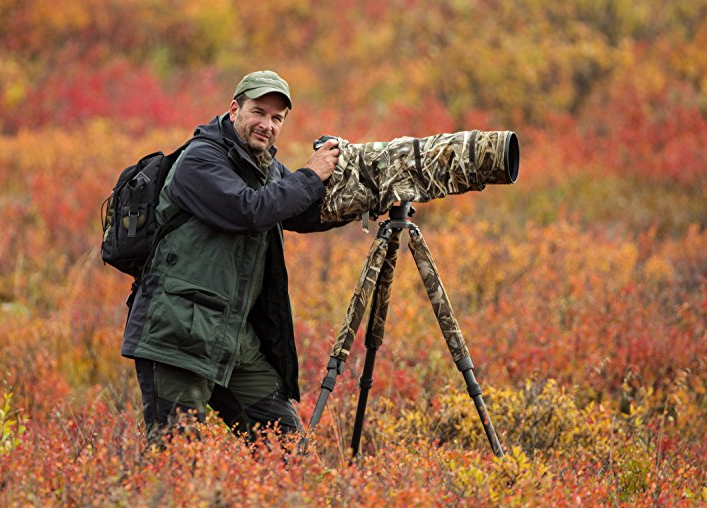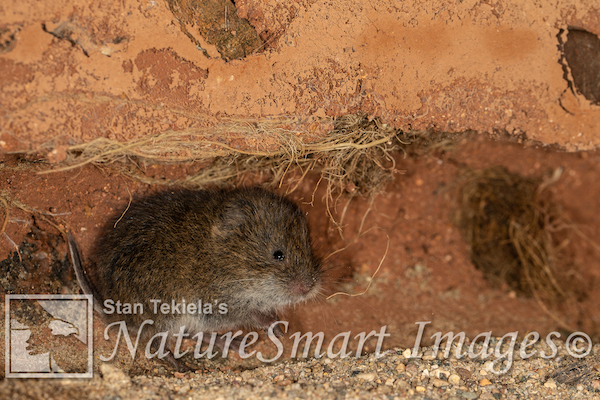The Meadow Vole, a Stout Little Critter
In this week’s post, wildlife photographer and naturalist Stan Tekiela introduces us to the meadow vole, a stout little critter with a distinctive short, blunt nose.

If you have followed any of my columns over the years, you no doubt know that I love all animals, from the tiny shrew to the mighty moose and everything in between. I find fascination and amazement in all the creatures, not just some of the cool ones. Recently, I was photographing a critter, and it occurred to me that, though this animal is incredibly common, I am willing to bet that most have never seen one, let alone know anything about it. It is the meadow vole (Mocrotus pennsylvanicus).
Meadow voles are different from mice and shrews in so many ways. Voles are stout little critters with a distinctive short, blunt nose, unlike mice and shrews, which have long, pointed snouts. They have thick, dark-brown fur; small, dark eyes; and adorable, tiny, fuzzy ears. Mice have larger eyes and naked ears. And voles have short tails, unlike mice, which have long tails.

Meadow voles are the most widespread of the approximately 50 species of voles in the United States. They live in open habitats with heavy vegetation across Canada and Alaska. They extend down and throughout the northern states and as far south as Georgia in the east. They also live in the Rocky Mountains of the west.
The front and back legs of voles are equal in size and strength, unlike those in mice, which have much larger and stronger hind legs that allow them to jump. The vole’s equal-size legs make them very efficient at traveling around at a fast trot on their network of paths and trails through thick vegetation.
The Meadow Vole Creates an Amazing Network of Trails
Each vole has a network of trails or paths that are laid out like streets in a neighborhood. The paths weave between the thick plant vegetation or just under the snow right at the earth’s surface. Either way, the paths are hard to see until a fire burns the vegetation or the snow melts, exposing the well-worn paths.
Voles are active all year long and maintain their network of trails, along with a series of nests that look like clumps of grass about the size of a softball or larger. There are usually well-worn trails leading to and from the nest sites. The inside of the nest chamber is clean because they have a separate spot for the latrine.
The meadow vole is an herbivore, eating mainly grasses, sedges, and seeds. They have remarkably dexterous feet, which allow them to hold onto the grasses they nip with their teeth before eating. They feed for short periods of time throughout the day and then rest. Voles practice coprophagy, which means they eat their own feces so that the plant material they consume makes a second pass through their digestive system to extract all possible nutrients. This is very common in other animals such as rabbits.
Vole populations have peaks and valleys over a five-year span. As in many other small animal species, the population cycles up and down. The driving force behind the peaks and valleys of population is still hotly debated. Some believe the population swings are driven from the bottom up by food availability or shortages, while others argue that the populations change from the top down by the pressures placed by predators. Either way, in any given area, the populations are always going up or crashing down.
Amazingly, the meadow vole can reproduce at any time of year, with summer litters averaging larger than winter litters. The typical litter size is 4 to 6 young, although it can have as many as 10. Gestation is only 21 days, and the females are ready to breed again almost immediately after giving birth. Newborns develop quickly and are weaned at 12-14 days of age. By 2 weeks of age, about 40 percent of the newborns have died or been killed. Within 30 days, about 90 percent of litters are lost, most of them to predation.
Lots of animals, from shrews and weasels to foxes, coyotes, and wolves, eat voles. Raptors such as owls and hawks concentrate on hunting voles too. They are highly sought-after food items, which explains why they breed so often and have so many offspring. They are critical for the health of other animals.
More books and posts by Stan Tekiela
If you enjoyed Stan’s post, you may consider one of his amazing nature books: Majestic Eagles; The Lives of Wolves, Coyotes, and Foxes or Backyard Birds: Welcomed Guests at our Gardens and Feeders. Young readers will delight in his award-winning children’s books, such as Whose Butt?, Critter Litter, and his latest, Jump, Little Wood Ducks.
You can follow Stan on Facebook and Twitter, or contact him via his web page. Stan’s nationally syndicated NatureSmart Column appears in more than 25 cities spanning 5 states (Minnesota, Wisconsin, Michigan, Illinois, and Pennsylvania) and is circulated to more than 750,000 readers. Stan’s author page on Amazon features some amazing videos! Check them out, and follow him for updates.
For more stories about wildlife and nature, sign up for our newsletter now!
More posts from Stan:
Indigo Bunting—A Familiar Summer Visitor
The Nesting Behaviors of Sandhill Cranes
Big Birds, Baby Birds, Birds Everywhere
Stan Tekiela observes Marsh Wrens
The Magical, Mystical World of Sandhill Cranes


